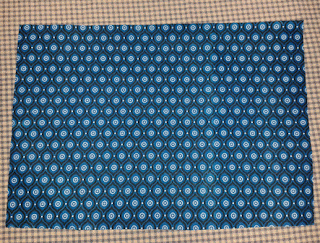 |
| BushcraftZ 2015 |
My husband moved his business and had four chairs from his
previous reception where the upholstery was stained otherwise the chairs were
in a good condition. They also did not fit into his new premises. We decided that these would make super patio
chairs.
I wanted to try using Annie SloanTM chalk paint
on upholstery for a long time. This was the ideal opportunity. It was important
to us to be able to wipe the chairs because in South Africa dust is a problem
on anything that stands outside. I also tried work on a way to get the painted
fabric water resistant so that we are able to wipe them with a damp cloth to
remove any dust. For this I used the Annie Sloan wax in three layers. The first
two layers I used wax diluted with mineral turpentine so that the wax could soak into
the fabric. The final layer was applied with undiluted wax to seal the fabric. Although
the chairs are standing outside under roof they are to some extend exposed to
the sun and moisture when it rains and of course, the ever present dust
especially during the dry months. We will have to see how long this treatment
lasts on the chairs.
I chose Aubusson blue as the base colour for the chairs as
it is a relatively neutral colour. I also thought that if the dust stains the
fabric over time it might add an additional dimension to the chairs when combined
with the blue. I hope that should this happen the effect will be similar to
using the dark wax on furniture. Only time will tell how that turns out. To add a bit of fun I painted words like LOVE,
EAT and LAUGH onto the seats in Graphite and added hearts with Burgundy.
- Office chairs with upholstered seat and back cushions
- 1L Aubusson blue Annie SloanTM Chalk paint ( This was enough for our 4 chairs)
- Annie SloanTM Chalk paint tester pots in Graphite and Burgundy
- 1x Annie SloanTM clear wax
- Mineral turpentine
- Brushes for the paint and the waxing
- Old tin to mix the wax with the turpentine
- Spritzer with water
- Craft heat gun (optional – I used my embossing heat gun)
Method.
(This method is a guide as every fabric will react
differently depending on the weave and pile of the fabric. Fabric with longer
pile might use more paint and wax.)
PAINTING
I was able to remove the upholstered parts from the metal frame
of the chairs. This made painting the upholstery easier as I did not have to
protect the perfectly intact galvanized metal.
Spritz the fabric with water to wet it slightly this helps
with getting the paint into the fabric. Be careful not to soak the fabric too
much. Use a brush and paint the fabric. The fabric on the chairs had a woven
pattern. I had to work the paint into the fabric with the brush in all
directions. If the paint was too thick in certain places I spritzed a little
water to help the paint soak into the fabric. Take care not to use too much
water otherwise it can look streaky and chalky. If this happens just paint a
second layer. Allow to dry. Repeat painting if the coverage is insufficient. Each chair was decorated with words and hearts. I
allowed the paint to dry in the sun and thereafter overnight to ensure that all
the moisture was gone from the upholstery before starting with the waxing
process.
 |
| BushcraftZ 2015 |
 |
| BushcraftZ 2015 |
 |
| BushcraftZ 2015 |
WAXING
When waxing work outside or in a well ventilated room. The fumes of the mineral turpentine are very unpleasant.
Spoon wax into a separate container and mix it with
turpentine until the wax is a very soft buttery consistency. Paint the diluted
wax onto the painted fabric working it well into grain of the fabric. At this
point I carefully used my heat gun to melt the wax into the fabric. I would
suggest that one test this first on an hidden area to ensure that the fabric
does not get damaged by the heat. In any case be very careful not to burn
yourself or the fabric. In my case the first layer of wax melted into the
fabric and looked great. If you do not have a heat gun place the waxed fabric
into the direct sun to allow the wax to melt into the fabric.
Add a second layer of wax diluted with turpentine. Allow to
dry in the sun and overnight.
For the final layer used undiluted wax and worked it well
into the fabric to seal the fabric. At this point I left the wax on the
upholstery to cure for a week before using the chairs in order to allow the wax
to seal in the paint.
Test for water resistance to ensure that the wax layers are
sufficient for your fabric.
 |
| BushcraftZ 2015 |
Assemble the chairs again and enjoy on the patio.
At this point I do
not know how long this treatment on the upholstery will last when exposed to
the elements, but for now we think it was worth the effort.
 |
| BushcraftZ 2015 |















































